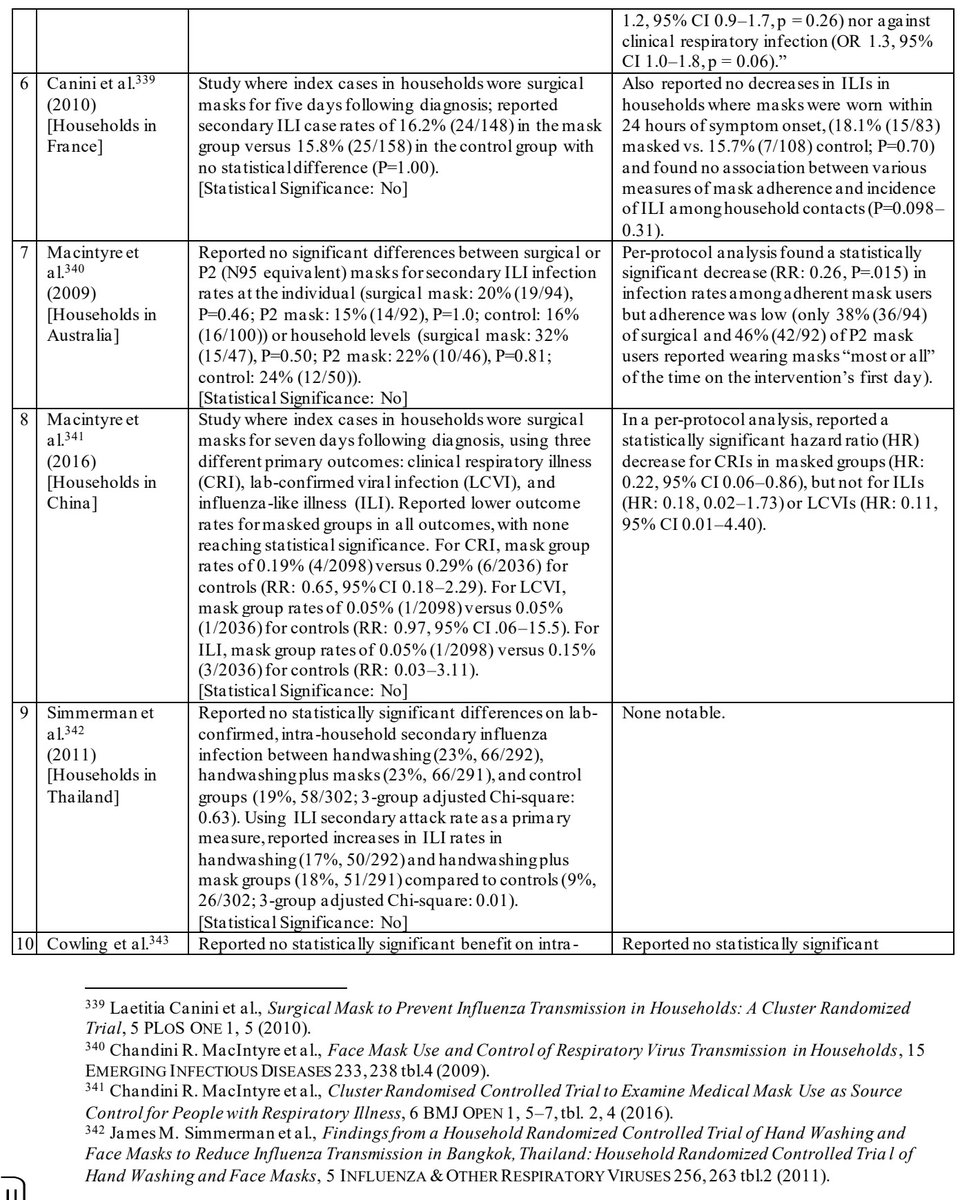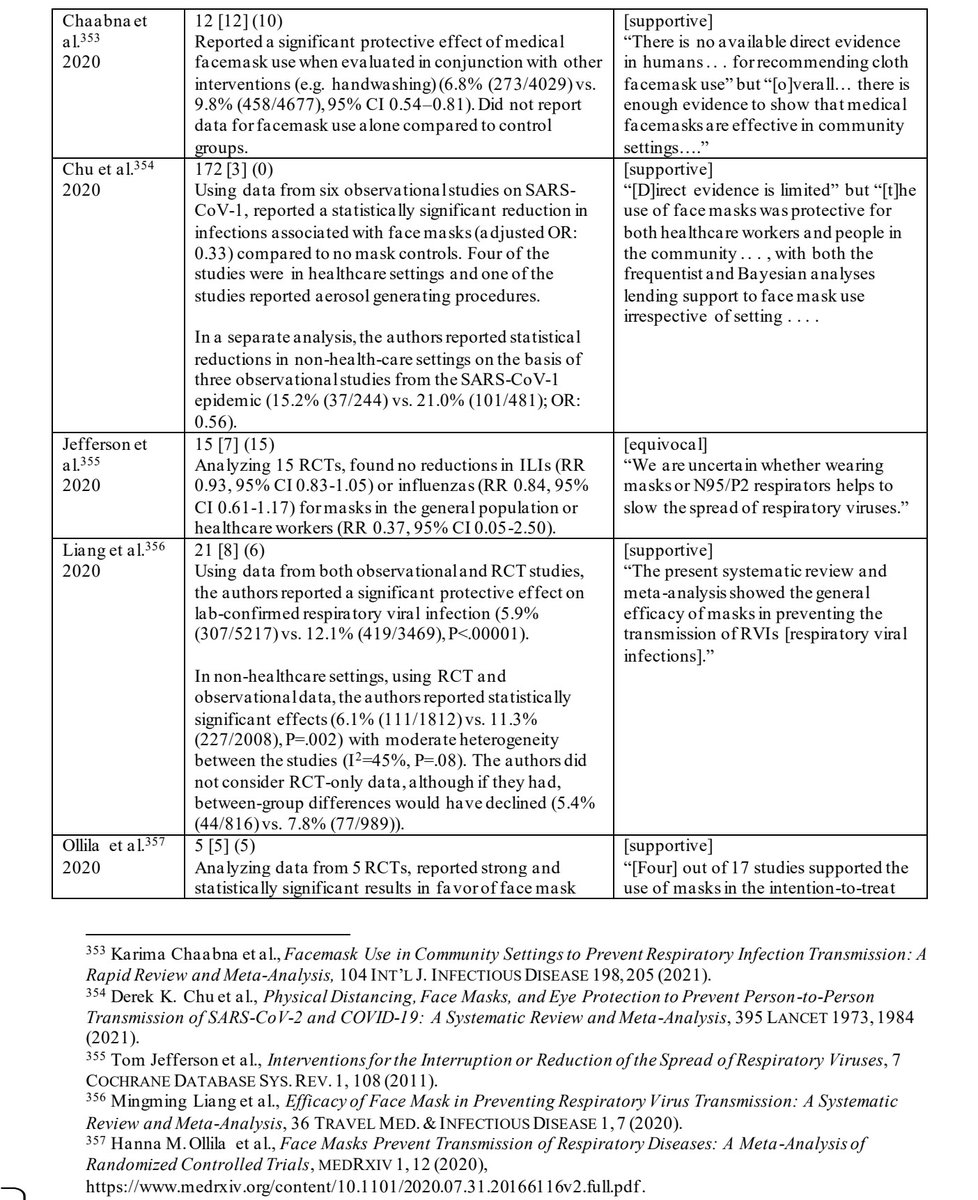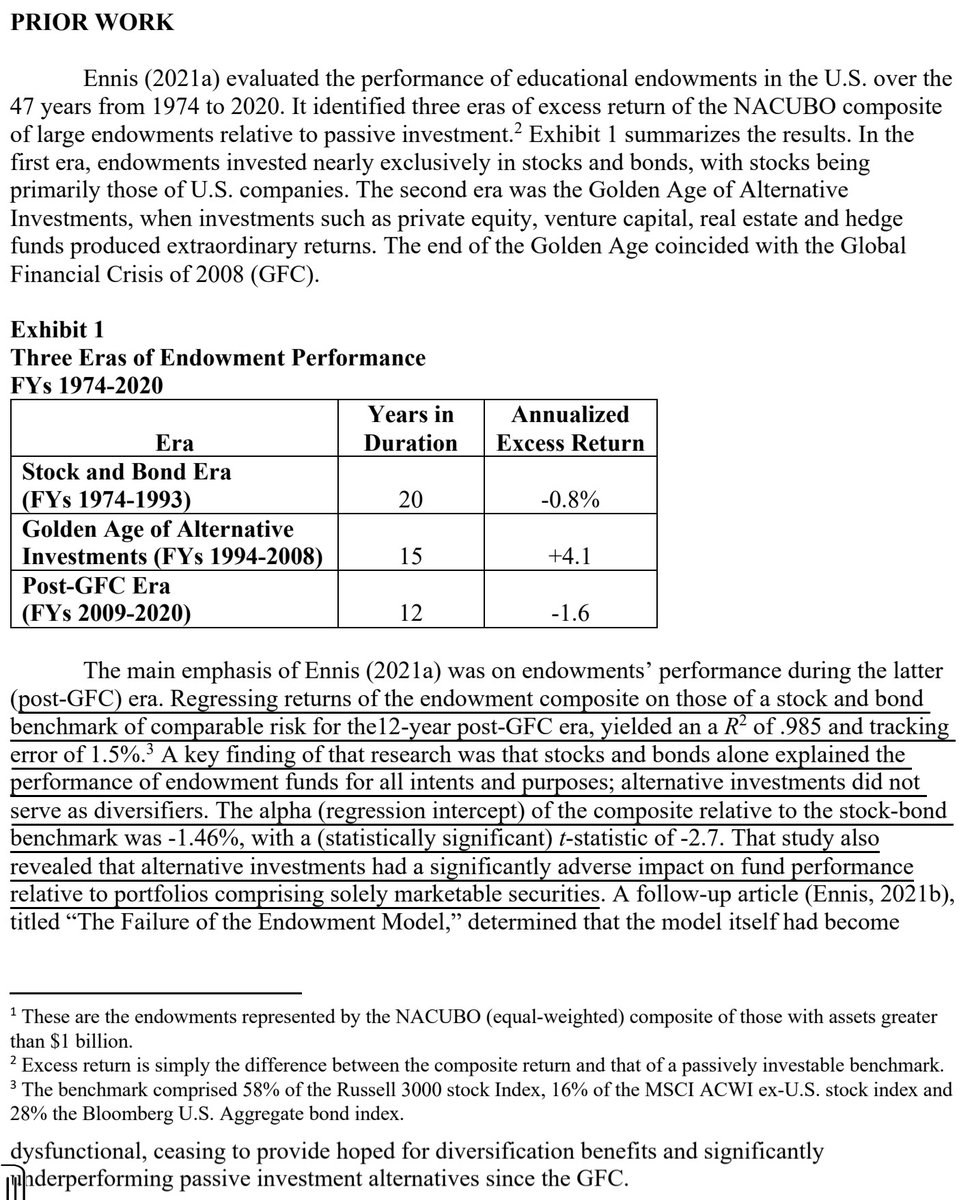
1/ Evidence for Community Cloth Face Masking to Limit the Spread of SARS‐CoV‑2: A Critical Review (Liu, Prasad, Darrow)
"The clinical evidence of mask efficacy is of low quality. The best available clinical evidence has mostly failed to show efficacy."
cato.org/working-paper/…
"The clinical evidence of mask efficacy is of low quality. The best available clinical evidence has mostly failed to show efficacy."
cato.org/working-paper/…

2/ "Aerosol transmission has been demonstrated or is considered likely for SARS-CoV, Middle East Respiratory Syndrome (MERS), H1N1, & respiratory syncytial virus. A growing body of laboratory, animal, & clinical evidence suggests SARS-CoV-2 is also spread via this mechanism." 



3/ "Most studies evaluating as-worn efficacy compare the number of particles collected inside/outside a mannequin head’s mask. Under these conditions, cloth masks have highly variable filtration qualities.
"Surgical masks outperform cloth masks but still have variable results."
"Surgical masks outperform cloth masks but still have variable results."

4/ "Only two randomized controlled trials have evaluated the efficacy of cloth masks against COVID-19.
"A Danish study found no stat. significant difference between a group receiving a recommendation to wear a surgical mask outside the home vs. control."


"A Danish study found no stat. significant difference between a group receiving a recommendation to wear a surgical mask outside the home vs. control."
https://twitter.com/ReformedTrader/status/1463701067321860096


5/ "A high-quality, cluster-randomized study of 342,000 adults spread across 600 villages in rural Bangladesh found that surgical masks reduced symptomatic seroprevalence rates by 0.09% vs. controls but that cloth masks did not offer a statistically significant rate reduction." 

6/ "The remainder of the available clinical evidence is primarily limited to non-randomized observational data, which are subject to confounding."
7/ "In addition to the two RCTs in the COVID-19 setting, at least 14 RCTs have assessed the relationship between mask-wearing and other respiratory infections.
"Four of the 5 RCTs examining mask-wearing in communal settings failed to find statistically significant results."
"Four of the 5 RCTs examining mask-wearing in communal settings failed to find statistically significant results."

8/ "All 8 RCTs examining face masks in household settings failed to find stat. significant results in intention-to-treat analyses.
"Two RCTs looked at facemasks as source-control measures to prevent secondary infection in household settings. Neither reported protective effects."

"Two RCTs looked at facemasks as source-control measures to prevent secondary infection in household settings. Neither reported protective effects."


9/ "A household RCT in Australia attempted to determine the protective effect for the wearer and found no sig. differences in secondary ILI infection at the individual level.
"5 RCTs evaluated mask wearing by all household members on secondary infection rates, w/ mixed results."
"5 RCTs evaluated mask wearing by all household members on secondary infection rates, w/ mixed results."
10/ "RCT evidence of face mask efficacy in healthcare settings is limited.
"Although surgical masks are worn during surgery, multiple studies have reported that the use of surgical masks as source control in operating theaters has not proven to reduce surgical site infection."
"Although surgical masks are worn during surgery, multiple studies have reported that the use of surgical masks as source control in operating theaters has not proven to reduce surgical site infection."

11/ "At least ten studies compare the clinical efficacy of types of masks, but without a no-mask control group, most provide little insight.
"A recent review found that evidence that N95s protect healthcare workers from clinical respiratory infections at all is 'low quality.'
"A recent review found that evidence that N95s protect healthcare workers from clinical respiratory infections at all is 'low quality.'
12/ "We identified 32 systematic reviews/meta-analyses evaluating community masking against respiratory viral transmission. Of 16 quantitative meta-analyses, 8 were critical or equivocal as to whether existing evidence was sufficient to support a public recommendation of masks. 







13/ "The remaining 8 supported a public mask intervention on the basis of existing evidence primarily due to the precautionary principle—i.e., based on the assumption that masks might help and are unlikely to harm—and on the basis of observational or other indirect evidence.
14/ "Of the 15 solely qualitative reviews identified by the authors, 7 concluded that evidence for community masking was weak. Seven cautiously concluded that mask benefits outweigh risks in various settings, often conceding that the evidence was only of low to moderate quality.
15/ "One unequivocally concluded that facemasks were beneficial.
"Despite their varying conclusions, these 15 qualitative reviews are largely redundant and chiefly evaluate evidence already discussed above.
"Despite their varying conclusions, these 15 qualitative reviews are largely redundant and chiefly evaluate evidence already discussed above.
16/ "The meta-analyses largely analyzed the same RCTs but used different methodologies and sometimes included different non-RCT observational studies. None considered the SARS-CoV-2 virus specifically, and most looked at surgical––not cloth––face mask use in community settings."
17/ "Although some evidence suggests masks may actually cause harm, such as breathing difficulties, psychological burdens, impaired communication, skin irritation or breakdown, and headaches, the most concerning potential harm to health is an increased rate of disease spread.
18/ "A number of studies have found higher point estimates of infection among mask wearers, some of which were statistically significant. 



19/ "The World Health Organization has noted the possibility that mask wearing could accelerate disease spread by providing a false sense of security that induces individuals to forego standard sanitary measures, although this concern is contested and the evidence is mixed."
20/ "Taken as a whole, the available mechanistic and clinical evidence leaves substantial uncertainty as to whether, to what extent, and under what circumstances community-wide use of cloth face masks helps to reduce infection rates of SARS-CoV-2.
21/ Regardless of images shown by the media, "droplet-based surrogates of efficacy have not been demonstrated to correlate with infection outcomes and therefore fail to show that masks reduce the spread of respiratory illness.
22/ "It is also not clear that mannequin studies adequately replicate real-world conditions even as to the surrogate of droplet transmission.
"Resources devoted to mask utilization & enforcement might be deployed to greater benefit via alternate interventions like vaccination."
"Resources devoted to mask utilization & enforcement might be deployed to greater benefit via alternate interventions like vaccination."
23/ Media Slant is Contagious
Is Newspaper Coverage of Economic Events Politically Biased?
Polarizing impact of science literacy and numeracy
When face masks signal social identity
https://twitter.com/ReformedTrader/status/1392876863500865538
Is Newspaper Coverage of Economic Events Politically Biased?
https://twitter.com/ReformedTrader/status/1383262208965025792
Polarizing impact of science literacy and numeracy
https://twitter.com/ReformedTrader/status/1411033851288117248
When face masks signal social identity
https://twitter.com/ReformedTrader/status/1463718652214067207
• • •
Missing some Tweet in this thread? You can try to
force a refresh






















